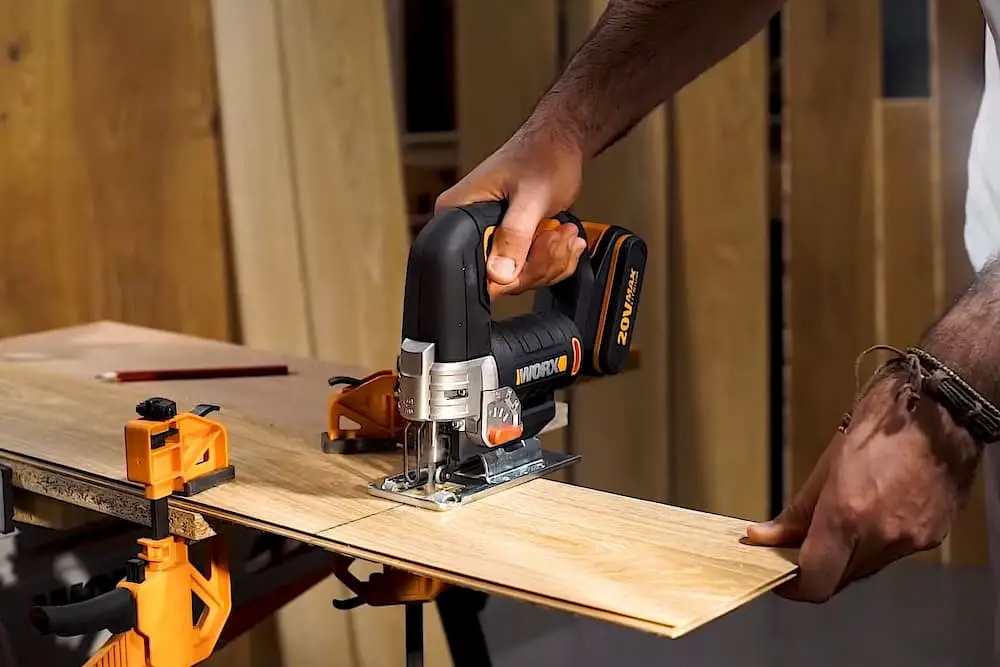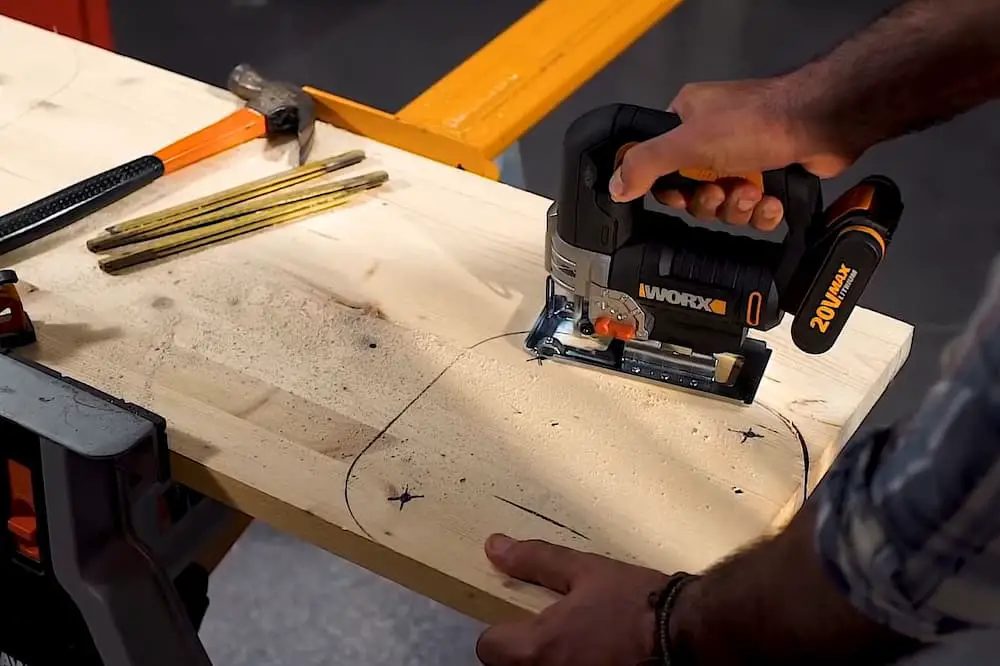Hey there, DIY aficionados! In this post, we’re tackling the ever-popular topic of cutting laminate materials, focusing specifically on laminate flooring and countertops.
Drawing from my personal experience and expertise, I’ll be your guide on how to master the art of laminate cutting with a jigsaw – a tool known for its versatility and ease of use.
We’ll delve into the numerous advantages of using a jigsaw for your laminate projects and walk you through the entire process, from start to finish, ensuring you achieve that polished, professional look you’re after.
So, grab your favorite jigsaw, and let’s get started on this exciting laminate cutting journey together!
Can I Cut Laminate Flooring with a Jigsaw?
You bet! As a matter of fact, a jigsaw holds a special place in my heart when it comes to cutting laminate flooring.
What sets it apart is its impressive maneuverability and precision, allowing you to effortlessly make complex cuts and work around tight corners. When you’ve got the perfect blade and mastered the proper technique, you’ll be well on your way to creating neat, seamless cuts for all your laminate flooring endeavors. Trust me, once you get the hang of it, you’ll wonder how you ever managed without your trusty jigsaw.
Can I Cut Laminate Countertops with a Jigsaw?
Indeed! A jigsaw proves to be a fantastic tool for cutting laminate countertops as well. It particularly shines when it comes to handling curved edges or making precise sink cutouts. Similar to cutting laminate flooring, the key to success lies in choosing the appropriate blade and mastering the correct technique. Once you’ve got those down, you can expect a sleek, professional-grade finish on your laminate countertops that will leave you feeling proud of your handiwork.
Choosing the Right Jigsaw and Blade for Laminate
Picking the right jigsaw is a crucial decision that can significantly impact your laminate cutting experience. Opt for a jigsaw that features variable speed settings, which give you the flexibility to fine-tune the cutting speed for enhanced control and minimal chipping. In my experience, I’ve observed that corded jigsaws often deliver steadier power, while cordless options boast greater mobility and ease of use. My article about the differences between corded and cordless jigsaws will help you to choose the tool that is right for you.
The blade selection for cutting laminate is equally important for ensuring clean, professional cuts. When working with laminate materials, a fine-toothed blade (10-12 TPI) with a downward cutting action is your best bet. This blade design reduces the chances of chipping and results in a neater cut. Remember, investing in a sharp, high-quality blade truly pays off in the long run.

Can I Use the Same Equipment for Cutting Laminate Flooring and Laminate Countertops?
Definitely! The great news is that you can use the same jigsaw and blade for cutting both laminate flooring and countertops. However, you might need to tweak your cutting technique to accommodate differences in material thickness and dimensions.
With a little practice, you’ll be well-equipped to handle both types of laminate projects with confidence.
Preparing the Laminate for Cutting
It’s vital to measure and mark your laminate with precision before diving into the cutting process. Use a straight edge and a pencil to draw clean, clear cutting lines. When tackling curved cuts, it’s helpful to use a template or craft a guide using painter’s tape to ensure you stay on track.
Providing adequate support for your laminate material is key to achieving a safe and accurate cut. For flooring, using sawhorses or a sturdy workbench should suffice. When working with countertops, you might need extra support in the form of clamps or even enlisting the help of a friend to hold the material steady while you cut.
To assist you in marking your laminate accurately, consider using tools like carpenter’s squares, T-squares, and compasses. But don’t underestimate the power of a steady hand and a patient approach – these qualities can make all the difference in ensuring your measurements are spot-on.
How to Cut Laminate Flooring and Countertop with a Jigsaw?
- Set up your workspace, ensuring the laminate material is well-supported.
- Adjust your jigsaw’s speed setting and attach the appropriate blade.
- Don’t forget your safety gear, such as goggles and ear protection.
- Start cutting along the marked line, maintaining a consistent pace and a firm grip on the jigsaw.
- Let the blade do its job, refraining from applying excessive pressure or force.
To achieve the desired control and accuracy during the cut, keep a steady hand and allow the blade to move at a natural pace. If necessary, take a break to reposition your grip or adjust the material support.
Chipping and binding are common challenges when cutting laminate flooring. To address these issues, opt for a fine-toothed blade, make relief cuts as needed, and resist the urge to force the jigsaw through the material. Let the tool do the work, and you’ll be rewarded with a smoother, cleaner cut.
Finishing the Laminate Edges
To achieve a smooth, refined finish on the cut edges of your laminate, you’ll want to use fine-grit sandpaper or a dedicated laminate file. Remember to sand or file in the same direction as the cut to prevent chipping or tearing the laminate surface.
A variety of tools and materials can be employed for finishing, including sandpaper, laminate files, and edge-trimming tools. Some seasoned DIYers even opt for a router equipped with a flush-trim bit to attain that professional touch.
In my experience, the secret to impeccable laminate edges lies in patience and a keen eye for detail. Take your time and focus on achieving a smooth, uniform finish. This extra effort will undoubtedly pay off, resulting in a polished, expertly crafted appearance that’s sure to impress.

What are the common laminate cutting mistakes?
- Choosing the incorrect blade type: Always opt for a fine-toothed blade (10-12 TPI) with a downward cutting action for laminate projects. Using the wrong blade can result in chipping or rough cuts.
- Forcing the jigsaw through the material: Allow the blade to do the work at its own pace instead of pushing the jigsaw aggressively. Forcing the tool can cause binding, chipping, or uneven cuts.
- Providing insufficient support for the laminate material: Proper support is crucial for safe, precise cutting. Ensure your laminate flooring or countertop is well-supported to avoid damage or accidents.
- Neglecting proper safety gear: Safety should always come first. Wear appropriate gear, such as goggles and ear protection, to prevent injuries while working with power tools.
- Skipping relief cuts when necessary: For tight corners and curves, making relief cuts can help prevent binding and chipping. Skipping this step could result in damage to your laminate material or an uneven cut.
What are jigsaw alternatives for cutting laminate?
- Circular saw: A fantastic option for making straight cuts, particularly when working with larger pieces. Just be sure to use a fine-toothed blade specifically designed for cutting laminate.
- Table saw: Tool like Bosch 4100-10 delivers incredibly precise and clean cuts when you need straight lines. Again, use a blade designed for cutting the laminate to achieve the best results.
- Router: Routers come in handy for trimming edges and crafting decorative profiles. Pair it with a flush-trim bit or an edge-forming bit to achieve a professional finish on your laminate edges.
- Handsaw: For smaller projects or situations where power tools aren’t accessible, a handsaw can be a practical choice. Opt for a fine-toothed handsaw to minimize chipping and achieve cleaner cuts in laminate materials.
Conclusion
Taking on laminate flooring and countertop cuts with a jigsaw is a doable DIY adventure for rookies and experienced handypersons alike. With the right jigsaw and blade combination and a dash of patience, you’re bound to produce professional-level results in your home improvement quests. So why not give it a whirl?
Trust me, if I can do it, so can you – I still remember the days when I thought a jigsaw was just a type of puzzle! Feel free to share your experiences, victories, or questions in the comments section below. Let’s keep learning and growing together on this DIY journey, one cut at a time!

